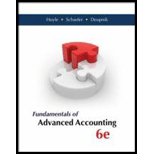
Fundamentals of Advanced Accounting
6th Edition
ISBN: 9780077862237
Author: Joe Ben Hoyle, Thomas Schaefer, Timothy Doupnik
Publisher: McGraw-Hill Education
expand_more
expand_more
format_list_bulleted
Question
Chapter 6, Problem 1Q
To determine
Explain the term variable interest entity (VIE).
Expert Solution & Answer
Answer to Problem 1Q
A legal business structure is known as variable interest entity when an investor has interest which is controlled even when not have majority of voting rights.
Explanation of Solution
A legal business structure is known as variable interest entity when an investor has interest which is controlled even when not have majority of voting rights. Commonly VIE activities includes leasing, financial assets, research and development, hedging financial instruments, and other arrangements transfers. Primary beneficiary is a term which is used to designate that party having control over VIE’s financial interest.
Want to see more full solutions like this?
Subscribe now to access step-by-step solutions to millions of textbook problems written by subject matter experts!
Students have asked these similar questions
Please provide the accurate answer to this financial accounting problem using valid techniques.
Please provide the correct answer to this financial accounting problem using valid calculations.
I need help with this financial accounting question using the proper financial approach.
Chapter 6 Solutions
Fundamentals of Advanced Accounting
Ch. 6 - Prob. 1QCh. 6 - Prob. 2QCh. 6 - Prob. 3QCh. 6 - Prob. 4QCh. 6 - Prob. 5QCh. 6 - Prob. 6QCh. 6 - Prob. 7QCh. 6 - Prob. 8QCh. 6 - Prob. 9QCh. 6 - Prob. 10Q
Ch. 6 - Prob. 11QCh. 6 - How do noncontrolling interest balances affect the...Ch. 6 - Prob. 13QCh. 6 - Prob. 14QCh. 6 - Prob. 15QCh. 6 - Prob. 16QCh. 6 - Prob. 17QCh. 6 - Prob. 1PCh. 6 - Prob. 2PCh. 6 - Prob. 3PCh. 6 - Prob. 4PCh. 6 - Prob. 5PCh. 6 - Prob. 6PCh. 6 - Prob. 7PCh. 6 - Bens man Corporation is computing EPS. One of its...Ch. 6 - Prob. 9PCh. 6 - Prob. 10PCh. 6 - Prob. 11PCh. 6 - Prob. 12PCh. 6 - Prob. 13PCh. 6 - Prob. 14PCh. 6 - Prob. 15PCh. 6 - On January 1, Coldwater Company has a net book...Ch. 6 - Prob. 17PCh. 6 - Prob. 18PCh. 6 - Prob. 19PCh. 6 - Prob. 20PCh. 6 - Prob. 21PCh. 6 - Prob. 22PCh. 6 - Prob. 23PCh. 6 - Prob. 24PCh. 6 - Prob. 25PCh. 6 - Prob. 26PCh. 6 - Prob. 27PCh. 6 - Prob. 28PCh. 6 - Prob. 29PCh. 6 - Prob. 30PCh. 6 - Prob. 31PCh. 6 - Prob. 32PCh. 6 - Prob. 33PCh. 6 - Prob. 34PCh. 6 - Prob. 35PCh. 6 - Prob. 36PCh. 6 - Prob. 37PCh. 6 - Prob. 38PCh. 6 - Prob. 39PCh. 6 - Prob. 40PCh. 6 - Prob. 41PCh. 6 - Prob. 42PCh. 6 - Prob. 43PCh. 6 - Prob. 44PCh. 6 - Prob. 45PCh. 6 - Prob. 46PCh. 6 - Prob. 47PCh. 6 - Prob. 48PCh. 6 - Prob. 1DYSCh. 6 - Prob. 2DYSCh. 6 - Prob. 3DYS
Knowledge Booster
Similar questions
- Nicole is a calendar-year taxpayer who accounts for her business using the cash method. On average, Nicole sends out bills for about $12,000 of her services on the first of each month. The bills are due by the end of the month, and typically 70 percent of the bills are paid on time and 98 percent are paid within 60 days. a. Suppose that Nicole is expecting a 2 percent reduction in her marginal tax rate next year. Ignoring the time value of money, estimate the tax savings for Nicole if she postpones mailing the December bills until January 1 of next year.arrow_forwardGeneral accountingarrow_forwardCan you solve this general accounting question with accurate accounting calculations?arrow_forward
arrow_back_ios
SEE MORE QUESTIONS
arrow_forward_ios
Recommended textbooks for you
 EBK CONTEMPORARY FINANCIAL MANAGEMENTFinanceISBN:9781337514835Author:MOYERPublisher:CENGAGE LEARNING - CONSIGNMENT
EBK CONTEMPORARY FINANCIAL MANAGEMENTFinanceISBN:9781337514835Author:MOYERPublisher:CENGAGE LEARNING - CONSIGNMENT


EBK CONTEMPORARY FINANCIAL MANAGEMENT
Finance
ISBN:9781337514835
Author:MOYER
Publisher:CENGAGE LEARNING - CONSIGNMENT